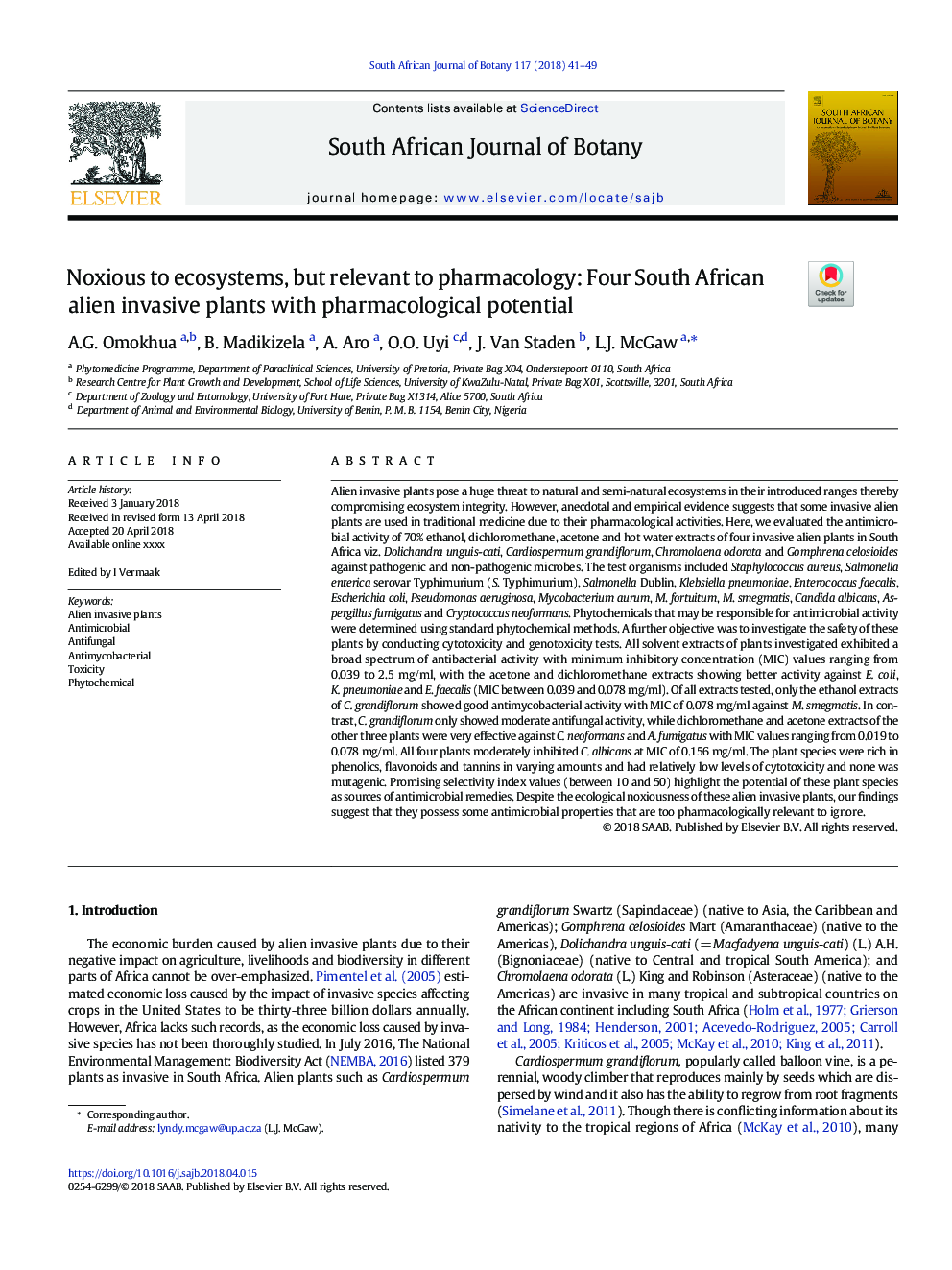| کد مقاله | کد نشریه | سال انتشار | مقاله انگلیسی | نسخه تمام متن |
|---|---|---|---|---|
| 8882244 | 1625141 | 2018 | 9 صفحه PDF | دانلود رایگان |
عنوان انگلیسی مقاله ISI
Noxious to ecosystems, but relevant to pharmacology: Four South African alien invasive plants with pharmacological potential
ترجمه فارسی عنوان
خطرناک به اکوسیستم ها، اما مربوط به فارماکولوژی: چهار گیاهان مهاجم بیگانه آفریقای جنوبی با پتانسیل
دانلود مقاله + سفارش ترجمه
دانلود مقاله ISI انگلیسی
رایگان برای ایرانیان
کلمات کلیدی
گیاهان مهاجم بیگانه، ضد میکروبی ضد قارچ، ضد میکروبی سمی بودن فیتوشیمیایی،
موضوعات مرتبط
علوم زیستی و بیوفناوری
علوم کشاورزی و بیولوژیک
علوم زراعت و اصلاح نباتات
چکیده انگلیسی
Alien invasive plants pose a huge threat to natural and semi-natural ecosystems in their introduced ranges thereby compromising ecosystem integrity. However, anecdotal and empirical evidence suggests that some invasive alien plants are used in traditional medicine due to their pharmacological activities. Here, we evaluated the antimicrobial activity of 70% ethanol, dichloromethane, acetone and hot water extracts of four invasive alien plants in South Africa viz. Dolichandra unguis-cati, Cardiospermum grandiflorum, Chromolaena odorata and Gomphrena celosioides against pathogenic and non-pathogenic microbes. The test organisms included Staphylococcus aureus, Salmonella enterica serovar Typhimurium (S. Typhimurium), Salmonella Dublin, Klebsiella pneumoniae, Enterococcus faecalis, Escherichia coli, Pseudomonas aeruginosa, Mycobacterium aurum, M. fortuitum, M. smegmatis, Candida albicans, Aspergillus fumigatus and Cryptococcus neoformans. Phytochemicals that may be responsible for antimicrobial activity were determined using standard phytochemical methods. A further objective was to investigate the safety of these plants by conducting cytotoxicity and genotoxicity tests. All solvent extracts of plants investigated exhibited a broad spectrum of antibacterial activity with minimum inhibitory concentration (MIC) values ranging from 0.039 to 2.5â¯mg/ml, with the acetone and dichloromethane extracts showing better activity against E. coli, K. pneumoniae and E. faecalis (MIC between 0.039 and 0.078â¯mg/ml). Of all extracts tested, only the ethanol extracts of C. grandiflorum showed good antimycobacterial activity with MIC of 0.078â¯mg/ml against M. smegmatis. In contrast, C. grandiflorum only showed moderate antifungal activity, while dichloromethane and acetone extracts of the other three plants were very effective against C. neoformans and A. fumigatus with MIC values ranging from 0.019 to 0.078â¯mg/ml. All four plants moderately inhibited C. albicans at MIC of 0.156â¯mg/ml. The plant species were rich in phenolics, flavonoids and tannins in varying amounts and had relatively low levels of cytotoxicity and none was mutagenic. Promising selectivity index values (between 10 and 50) highlight the potential of these plant species as sources of antimicrobial remedies. Despite the ecological noxiousness of these alien invasive plants, our findings suggest that they possess some antimicrobial properties that are too pharmacologically relevant to ignore.
ناشر
Database: Elsevier - ScienceDirect (ساینس دایرکت)
Journal: South African Journal of Botany - Volume 117, July 2018, Pages 41-49
Journal: South African Journal of Botany - Volume 117, July 2018, Pages 41-49
نویسندگان
A.G. Omokhua, B. Madikizela, A. Aro, O.O. Uyi, J. Van Staden, L.J. McGaw,
